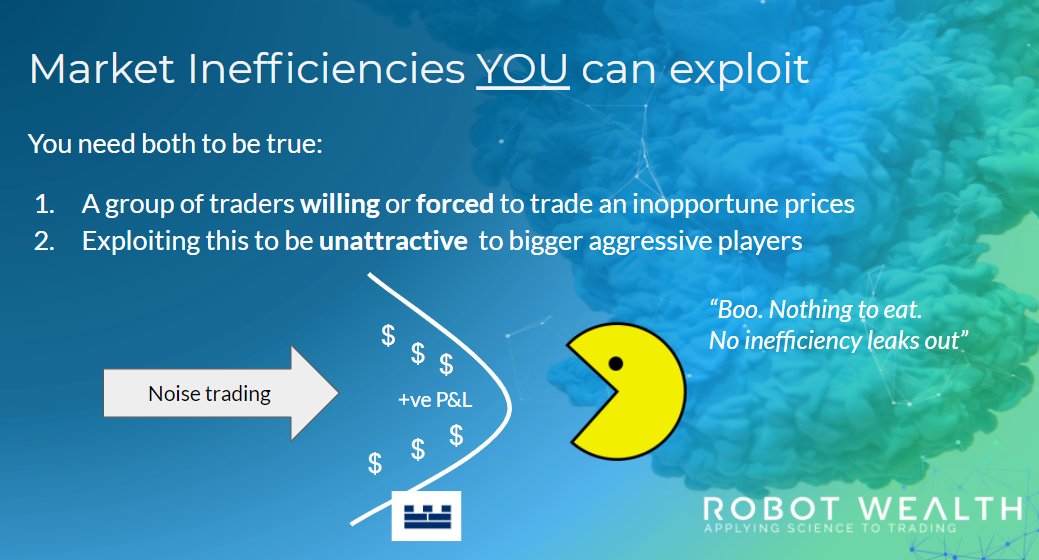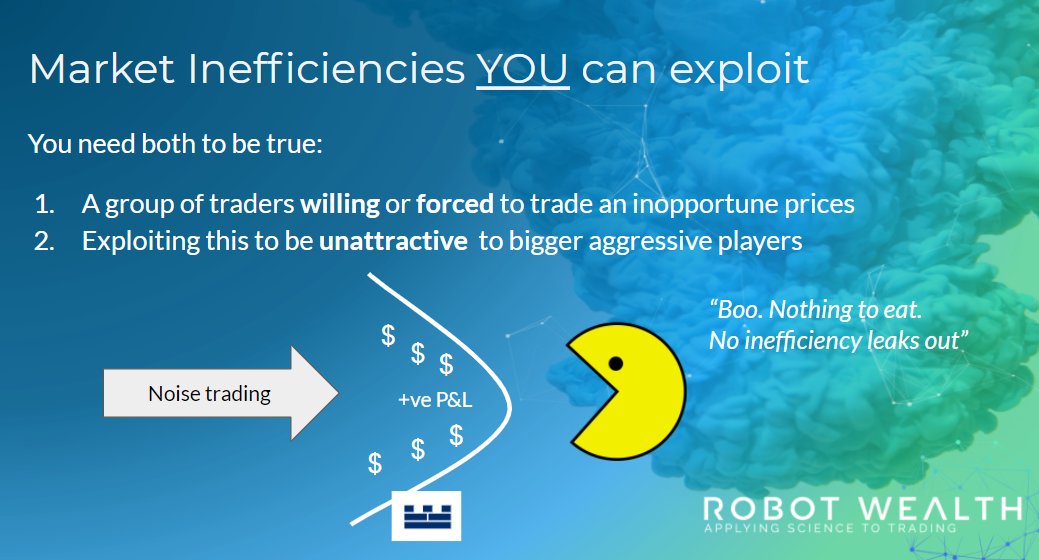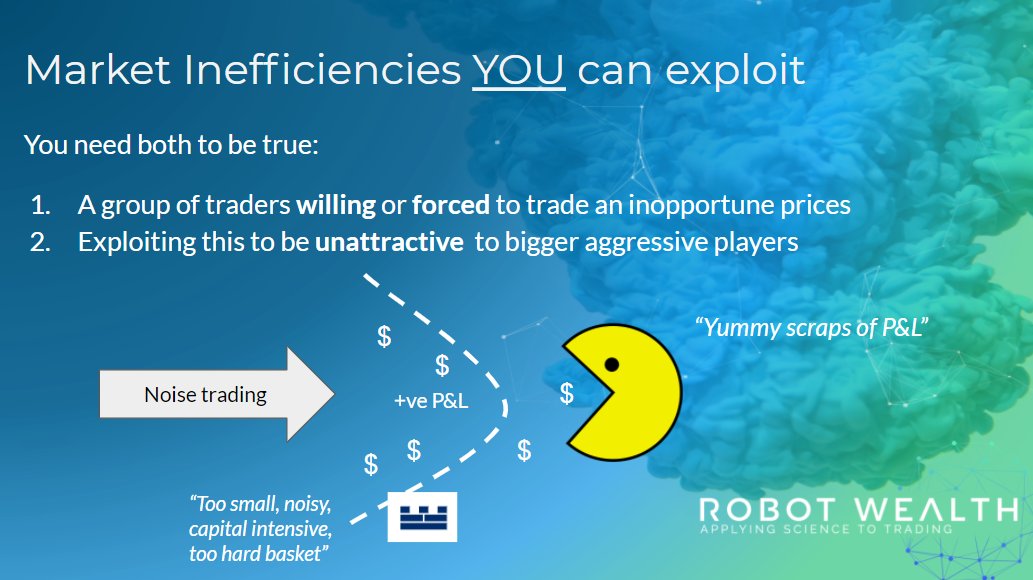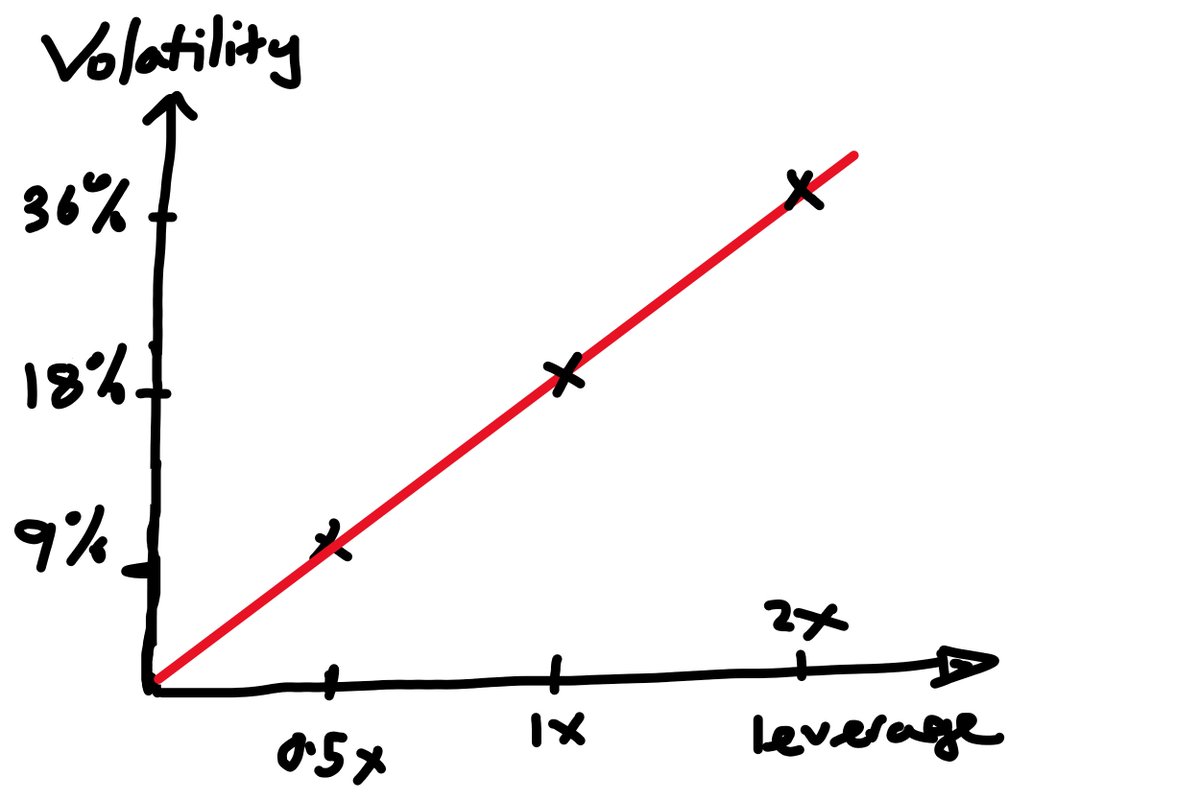
In the "win-lose" games of active trading, your "edge" comes from:
- Buying from someone too cheap
- Selling to someone too expensive
At least on average.
To do this, you need to know who you are playing against.
🧵on "edge", where to find it, and how you can compete 👇
1/n
- Buying from someone too cheap
- Selling to someone too expensive
At least on average.
To do this, you need to know who you are playing against.
🧵on "edge", where to find it, and how you can compete 👇
1/n
If you are a market maker, it is relatively clear to understand who you are trading against.
If you're a positional trader, it is perhaps less clear.
On a trivial level, you're probably trading with a market maker.
2/n
If you're a positional trader, it is perhaps less clear.
On a trivial level, you're probably trading with a market maker.
2/n
But understand that "the market line" is set by the supply/demand pressures of other aggressive traders.
- End users (wealth mgmt, retail)
- Aggressive prop traders doing short term risky arbs
- Informed positional traders with pricing models + (maybe) info advantages
3/n
- End users (wealth mgmt, retail)
- Aggressive prop traders doing short term risky arbs
- Informed positional traders with pricing models + (maybe) info advantages
3/n
It is easy to understand why "end users" would be prepared to trade at inopportune prices.
- perhaps they don't know any better.
- perhaps they are operating under *constraints* (they HAVE to sell/rebalance even though they don't WANT to)
4/n
- perhaps they don't know any better.
- perhaps they are operating under *constraints* (they HAVE to sell/rebalance even though they don't WANT to)
4/n
- perhaps they need to get an investment committee together before they can make a trading decision
- perhaps they are * incentivized* to do things that don't maximize their expected returns (window-dressing, return chasing, defensive posnig around the reporting cycle)
5/n
- perhaps they are * incentivized* to do things that don't maximize their expected returns (window-dressing, return chasing, defensive posnig around the reporting cycle)
5/n
In an uncompetitive trading environment, it would be easy for you to get an edge in the markets by understanding the above.
You could get paid for selling to these traders when they were FORCED to buy, due to their constraints.
6/n
You could get paid for selling to these traders when they were FORCED to buy, due to their constraints.
6/n
You could get paid for buying trash from fund managers that were interested in "tidying the book" for window-dressing around exposure reporting dates.
And also from selling them the "respectable-looking" stuff they want to rotate into.
7/n
And also from selling them the "respectable-looking" stuff they want to rotate into.
7/n
You could get paid for fading short-term supply/demand imbalances caused by impatient noise traders.
You get the idea...
It's clear that in an uncompetitive market, we could make good money trading.
There's plenty of uninformed money out there!
8/n
You get the idea...
It's clear that in an uncompetitive market, we could make good money trading.
There's plenty of uninformed money out there!
8/n
HOWEVER... (big however)... we don't trade in an uncompetitive market!
We trade in a highly competitive one!
There are highly sophisticated, fast, trading firms like Citadel competing to trade the short-term inefficiencies.
9/n
We trade in a highly competitive one!
There are highly sophisticated, fast, trading firms like Citadel competing to trade the short-term inefficiencies.
9/n
And there are sophisticated analysts running pricing models at hedge funds and banks making it difficult to get an edge on pricing/valuation with public knowledge.
The intense competition means that prices tend to be extremely efficient.
10/n
The intense competition means that prices tend to be extremely efficient.
10/n
I don't necessarily mean that everything trades at the "right" price (if we could know such a thing)
I mean that it's hard to make money trading both in the short term and the long term.
The aggressive competition for P&L is what *causes* this:
11/n
I mean that it's hard to make money trading both in the short term and the long term.
The aggressive competition for P&L is what *causes* this:
https://twitter.com/therobotjames/status/1381387162730422272
11/n
It's essential to identify the inefficient behaviour of "end users" players.
But it's not enough!
We're in massive competition with aggressive trading firms to exploit it. And it's a game most of us can't compete in.
So you need to find places where competition is low.
12/n
But it's not enough!
We're in massive competition with aggressive trading firms to exploit it. And it's a game most of us can't compete in.
So you need to find places where competition is low.
12/n
There's a reason Citadel buys order flow from Robinhood.
Because they know it's noise trading.
So they're confident they can "eat all the edge" so no tradeable inefficiencies escape.
You can think of it as a big net around all the inefficiencies
13/n
Because they know it's noise trading.
So they're confident they can "eat all the edge" so no tradeable inefficiencies escape.
You can think of it as a big net around all the inefficiencies
13/n

You could sit outside the net with your mouth open like pacman here...
But all the good stuff will have been kept in the net and eaten by the big boys.
You'd just be eating noise.
Noise is not tasty.
14/n
But all the good stuff will have been kept in the net and eaten by the big boys.
You'd just be eating noise.
Noise is not tasty.
14/n

But not everything is always so neatly contained.
Sometimes inefficiency leaks out because exploiting it is relatively unattractive.
Maybe the flows are just too massive to be fully contained.
Maybe the opportunities are too small, too capital intensive, too awkward...
15/n
Sometimes inefficiency leaks out because exploiting it is relatively unattractive.
Maybe the flows are just too massive to be fully contained.
Maybe the opportunities are too small, too capital intensive, too awkward...
15/n
If it's not worth the big boys getting out of bed for, then opportunity can leak through...
So, if you know where and when to sit with your mouth open, you can feed yourself on noisy alpha scraps like this happy pacman here.
16/n
So, if you know where and when to sit with your mouth open, you can feed yourself on noisy alpha scraps like this happy pacman here.
16/n

Now you know what needs to be true to identify inefficiencies you can exploit.
You need:
1. A group of traders willing or forced to trade at inopportune prices
2. Exploiting this to be unattractive to aggressive players.
Both of these pieces need to be in place.
17/n
You need:
1. A group of traders willing or forced to trade at inopportune prices
2. Exploiting this to be unattractive to aggressive players.
Both of these pieces need to be in place.
17/n
To help you with this, I teach you to think of "business cases" or "elevator pitches" for trades.
These are simple descriptions of what, why, and how you could make money from a market effect.
A 5 yo should understand it and find it reasonable.
robotwealth.com/trade-like-a-q…
18/n
These are simple descriptions of what, why, and how you could make money from a market effect.
A 5 yo should understand it and find it reasonable.
robotwealth.com/trade-like-a-q…
18/n
These "elevator pitches" are simple statements of:
WHAT would cause the inefficiency
WHY it wouldn't be fully "gobbled up" by other aggressive traders who are faster or better informed
HOW you might harness it, on average.
19/n
WHAT would cause the inefficiency
WHY it wouldn't be fully "gobbled up" by other aggressive traders who are faster or better informed
HOW you might harness it, on average.
19/n

Sometimes, if this is compelling enough, this is enough to start designing a strategy to exploit the effect.
But if you have enough data, you'll want to look for evidence in the past data that you could have exploited the effect.
Simple data analysis is your friend.
20/n
But if you have enough data, you'll want to look for evidence in the past data that you could have exploited the effect.
Simple data analysis is your friend.
20/n

You start thinking about HOW you're going to trade an effect, once you have:
- An "elevator pitch" for why YOU can exploit the effect
- Significant evidence of it in the past data.
Then you want the simplest trading rules to exploit the effect.
21/n
- An "elevator pitch" for why YOU can exploit the effect
- Significant evidence of it in the past data.
Then you want the simplest trading rules to exploit the effect.
https://twitter.com/therobotjames/status/1382420222502604803
21/n
Cos every time you add a new rule, you add a new way to screw up.
Once you have a simple set of rules, you might do some simulation (backtesting) to validate your assumptions.
22/n
https://twitter.com/therobotjames/status/1383954970341380100
Once you have a simple set of rules, you might do some simulation (backtesting) to validate your assumptions.
22/n
Then, trade it with discipline.
Understand the things underlying the effect, and check that they're still valid (so you're not dependent on poor P&L to turn off).
And chill out, and find some more stuff to trade.
23/n
Understand the things underlying the effect, and check that they're still valid (so you're not dependent on poor P&L to turn off).
And chill out, and find some more stuff to trade.
23/n
Summary:
To find an inefficiency you can exploit you need to understand market structure, the players, and their constraints and incentives.
You need:
1. many traders willing or forced to trade at inopportune prices
2. exploiting this to be unattractive to the best players
Fin
To find an inefficiency you can exploit you need to understand market structure, the players, and their constraints and incentives.
You need:
1. many traders willing or forced to trade at inopportune prices
2. exploiting this to be unattractive to the best players
Fin
• • •
Missing some Tweet in this thread? You can try to
force a refresh







